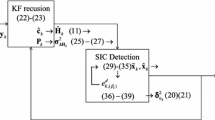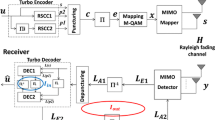Abstract
Requirements for higher data rates and lower power consumption set new challenges for hardware implementation of multiple-input multiple-output orthogonal frequency division multiplexing receivers. Simple detectors have the advantage of low complexity and power consumption, but they cannot offer as good performance as more complex detectors. Therefore, it would be beneficial to be able to adapt the detector algorithm to suit the channel conditions to minimize the receiver processing power consumption while satisfying the quality of service requirements. At low signal-to-noise ratio and/or low rank channel, more power and computation resources could be used for detection in order to guarantee reliable communication, while in good conditions, a simple and less power consuming detector could be used. In this paper, we compare the performance of different detection algorithms. The performance results are based on simulations in a long term evolution system where precoding and hybrid automatic repeat request are used. The effect of channel estimation on the performance is shown. Theoretical complexities of the detectors as numbers of arithmetic operations are presented. Also hardware implementation results based on the existing literature are included in the comparison. We discuss when it would be beneficial to use a complex detector and when a simple one would be sufficient and what kind of impact the channel estimation has on the choice of the detector.












Similar content being viewed by others
References
3rd Generation Partnership Project. (3GPP). (2010). Technical specification group radio access network. Evolved universal terrestrial radio access E-UTRA; physical channels and modulation (release 10) TS 36.211 (version 10.0.0), Technical Report.
Bai, L., & Choi, J. (2012). Low complexity MIMO detection. New York: Springer.
Paulraj, A., Nabar, R. D., & Gore, D. (2003). Introduction to space-time wireless communications. Cambridge: Cambridge University Press.
Lupas, R., & Verdú, S. (1989). Linear multiuser detectors for synchronous code-division multiple-access channels. IEEE Transaction on Informatics Theory, 34(1), 123–136.
Artes, H., Seethaler, D., & Hlawarsch, F. (2003). Efficient detection algotihms for MIMO channels: A geometrical approach to approximate ML detection. IEEE Transaction on Signal Processing, 51(11), 2808–2820.
Wolniansky, P. W., Foschini, G. J, Golden, G. D., & Valenzuela, R. A. (1998). V-BLAST: An architecture for realizing very high data rates over the rich-scattering wireless channel. In International Symposium on Signals, Systems, and Electronics (ISSSE) (pp. 295–300), Pisa.
Fincke, U., & Pohst, M. (1985). Improved methods for calculating vectors of short length in a lattice, including a complexity analysis. Mathmatical Computational, 44(5), 463–471.
Hochwald, B., & ten Brink, S. (2003). Achieving near-capacity on a multiple-antenna channel. IEEE Transaction on Communication, 51(3), 389–399.
Anderson, J., & Mohan, S. (1984). Sequential coding algorithms: A survey and cost analysis. IEEE Transaction on Communication, 32(2), 169–176.
Guo, Z., & Nilsson, P. (2006). Algorithm and implementation of the K-best sphere decoding for MIMO detection. IEEE Journal of Selected Areas in Communication, 24(3), 491–503.
Myllylä, M., Silvola, P., Juntti, M., & Cavallaro, JR. (2006). Comparison of two novel list sphere detector algorithms for MIMO–OFDM systems. In Proceeding on IEEE International Symposium Person, Indoor, Mobile Radio Communications(pp. 12–16), Helsinki.
Wong, K., Tsui, C., Cheng, R. K., & Mow, W. (2002). A VLSI architecture of a K-best lattice decoding algorithm for MIMO channels. In Proceeding on IEEE International Symposium on Circuits and Systems (vol. 3, pp. 273–276). Scottsdale, AZ.
Li, M., Bougart, B., Lopez E., & Bourdoux, A. (2008). Selective spanning with fast enumeration: A near maximum-likelihood MIMO detector designed for parallel programmable baseband architectures. In Proceeding on IEEE International Conference on Communication (pp. 737–741), Beijing.
Onggosanusi, E. N., Dabak, A. G., & Hosur, S. (2006). Multimode detection. U.S. 2006/0018410 A1 Patent.
Maurer, J., Matz, G., & Seethaler, D. (2007). Low-complexity and full-diversity MIMO detection based on condition number thresholding. In Proceeding IEEE International Conference on Acoustics Speech and Signal Processing (vol. 3, pp. 61–64), Honolulu, Hawaii.
Shen, H., Zhang, H., & Zhao, C. (2011). An efficient adaptive receiver for MIMO–OFDM systems. In Proceeding of International Conference on Wireless Communication and Signaling Process (pp. 1–5), Nanjing.
Chen, X., Minwegen, A., Hassan, Y., Kammler, D., Li, S., Kempf, T., Chattopadhyay, A., & Ascheid, G. (2012). FLEXDET: Flexible, efficient multi-mode MIMO detection uding reconfigurable ASIP. In Proceeding of International Symposuim on Field-Programmable Custom Computing Machines, 3, 69–76.
Suikkanen, E., Janhunen, J., Shahabuddin, S., & Juntti, M. (2013). Study of adaptive detection for MIMO–OFDM systems. In Proceeding on International Symposium on System-on-Chip, Tampere.
Lin, S., Daniel, M. J. M., & Jr Costello, J. (1984). Automatic-repeat-request error-control scheme. IEEE Transactions on Magnetics, vol. 22(no. 12).
Chase, D. (1985). Code combining-a maximum-likelihood decoding approach for combining an arbitrary number of noisy packets. IEEE Transactions on Communications, 33(5), 385–393.
Ketonen, J., Juntti, M., & Cavallaro, J. (2010). Performance-complexity comparison of receivers for a LTE MIMO–OFDM system. IEEE Transaction on Signal Processing, 58(6), 3360–3372.
Schnorr, C. P., & Euchner, M. (1994). Lattice basis reduction: Improved practical algorithms and solving subset sum problems. Mathmatical Programming, 66(2), 181–191.
Hassibi, B. (2000). A fast square-root implementation for BLAST. In Proceeding on Annual Asilomar Conference Signals, Systems and Computering (vol. 2, pp. 1255–1259). Asilomar.
Wübben, D., Böhnke, R., Kühn, V., & Kammeyer, K.-D. (2003). MMSE extension of V-BLAST based on sorted QR decomposition. In Proceeding on IEEE Vehicular Technology Conference on (vol. 1, pp. 508–512). Orlando, Florida.
Golub, G. H., & Loan, C. F. V. (1989). Matrix computations (2nd ed.). Baltimore: The Johns Hopkins University Press.
Tse, D., & Viswanath, P. (2005). Fundamentals of wireless communication. Cambridge: Cambridge University Press.
Tong, L., Sadler, B. M., & Dong, M. (2004). Pilot-assisted wireless transmissions: General model, design criteria, and signal processing. IEEE Signal Processing Magazine, 21(6), 12–25.
Ozdemir, M. K., & Arslan, H. (2007). Channel estimation for wireless OFDM systems. IEEE Communications Surveys & Tutorials, 9(2), 18–48.
Kay, S. M. (1993). Fundamentals of statistical signal processing: Estimation theory. Englewood Cliffs: Prentice-Hall.
van de Beek, J.-J., Edfors, O., Sandell, M., Wilson, S., & Borjesson, P. (1995). On channel estimation in OFDM systems. In Proceeding on IEEE Vehicular Technology Conference (vol. 2, pp. 815–819). Chicago, IL.
Miao, H., & Juntti, M. (2005). Space-time channel estimation and performance analysis for wireless MIMO–OFDM systems with spatial correlation. IEEE Transactions on Vehicular Technology, 54(6), 2003–2016.
Ketonen, J., Juntti, M., Ylioinas, J., & Cavallaro, J.R. (2012). Implementation of LS, MMSE and SAGE channel estimators for mobile MIMO–OFDM. In Proceeding of Annual Asilomar Conference on Signals, Systems and Computer (pp. 1092–1096). Pacific Grove.
Morelli, M., & Mengali, U. (2001). A comparison of pilot-aided channel estimation methods for OFDM systems. IEEE Transaction on Signal Processing, 49(12), 3065–3073.
3rd Generation Partnership Project (3GPP). (2002). Technical specification group radio access network. Radio transmission and reception (3G TS 45.005 version 5.4.0 (release 5)). 3rd Generation Partnership Project (3GPP), Technical Report.
Ketonen, J. (2012). Equalization and channel estimation algorithms and implementations for cellular MIMO–OFDM downlink. Ph.D. dissertation, Acta Univ. Oul., C Technica 423, Oulu: University of Oulu.
Janhunen, J. (2011). Programmable MIMO detectors. Ph.D. dissertation, Acta Univ. Oul., C Technica 404, Oulu: University of Oulu.
Author information
Authors and Affiliations
Corresponding author
Additional information
This research was financially supported in part by Tekes, the Finnish Funding Agency for Innovation, Academy of Finland, Nokia Networks, Broadcom Communications Finland and Xilinx.
Rights and permissions
About this article
Cite this article
Suikkanen, E., Juntti, M. Study of Adaptive Detection and Channel Estimation for MIMO–OFDM Systems. Wireless Pers Commun 93, 811–831 (2017). https://doi.org/10.1007/s11277-014-2230-0
Published:
Issue Date:
DOI: https://doi.org/10.1007/s11277-014-2230-0




